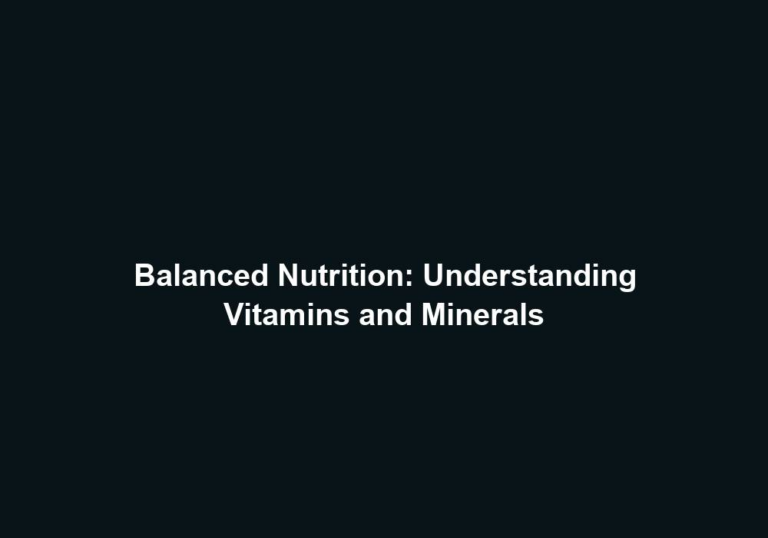Going Whole: Exploring the Spectrum of Nutritious Whole Grains
Whole grains have gained significant popularity in recent years due to their numerous health benefits. Packed with essential nutrients, fiber, and antioxidants, whole grains are an integral part of a balanced diet. In this article, we will delve into the world of whole grains, exploring their diverse range, nutritional value, and the many ways they can be incorporated into our daily meals.
What are Whole Grains?
Whole grains are grains that retain all parts of the grain kernel, including the bran, germ, and endosperm. This ensures that all the essential nutrients, such as fiber, vitamins, minerals, and antioxidants, are present in the final product. By consuming whole grains, you are getting the full nutritional package that nature intended. In contrast, refined grains undergo a process that removes the bran and germ, resulting in a loss of valuable nutrients.
The Nutritional Value of Whole Grains
Whole grains are a powerhouse of nutrition, offering a wide array of health benefits. One of the key components of whole grains is dietary fiber, which plays a crucial role in supporting digestive health, promoting satiety, and helping regulate blood sugar levels. The high fiber content in whole grains can aid in weight management and reduce the risk of developing conditions such as obesity, type 2 diabetes, and heart disease.
In addition to fiber, whole grains are rich in vitamins and minerals. B vitamins, including thiamine, niacin, and folate, are essential for energy production, brain function, and overall health. Vitamin E, an antioxidant, helps protect cells from damage caused by free radicals. Minerals such as magnesium, selenium, and iron are also abundant in whole grains. Magnesium is important for bone health, selenium acts as an antioxidant and supports thyroid function, while iron is vital for oxygen transport in the body, preventing anemia and ensuring optimal energy levels.
Moreover, whole grains are a great source of antioxidants, which help combat oxidative stress and reduce the risk of chronic diseases, including heart disease, certain cancers, and age-related macular degeneration. These powerful compounds work to neutralize harmful free radicals and protect our cells from damage.
The Diverse Range of Whole Grains
Whole grains come in many shapes, sizes, and flavors, making them a versatile ingredient for various dishes. Here are some popular examples of whole grains:
-
Oats: Oats are a classic whole grain that comes in various forms such as rolled oats, steel-cut oats, and oat flour. They are a great source of soluble fiber, which can help lower cholesterol levels and improve heart health. Oats are also rich in antioxidants and contain unique compounds called beta-glucans, which have been shown to enhance immune function and reduce the risk of certain diseases.
-
Quinoa: Quinoa is a gluten-free grain that is often referred to as a “superfood” due to its exceptional nutritional profile. It is a complete protein, meaning it contains all essential amino acids. Quinoa is also high in fiber, magnesium, and iron. Its versatility makes it a popular choice for salads, side dishes, or as a substitute for rice.
-
Brown Rice: Brown rice retains the bran and germ, making it a more nutritious alternative to white rice. It is high in fiber and contains beneficial antioxidants. Brown rice is also a good source of manganese, which plays a role in metabolism and bone health.
-
Whole Wheat: Whole wheat is a commonly used whole grain that is readily available in flour form. It can be used to make bread, pasta, and other baked goods. Whole wheat is packed with fiber, B vitamins, and minerals such as selenium and magnesium. Choosing whole wheat products over refined wheat can help increase your intake of essential nutrients.
-
Barley: Barley is a hearty grain that adds a nutty flavor and chewy texture to soups, stews, and salads. It is high in fiber and provides various vitamins and minerals, including selenium, manganese, and phosphorus. Barley is also known for its beta-glucan content, which can help lower cholesterol levels and improve heart health.
These are just a few examples, but there is a wide range of whole grains available, each with its unique nutritional profile and culinary uses. Other notable whole grains include bulgur, millet, amaranth, and wild rice.
Incorporating Whole Grains into Your Diet
Integrating whole grains into your diet is easier than you may think. Here are some tips to help you make the most of their nutritional benefits:
-
Start your day with whole grains: Enjoy a bowl of whole grain cereal or oatmeal for a nutritious and filling breakfast. You can add fruits, nuts, or seeds for extra flavor and nutrients.
-
Swap refined grains for whole grains: Replace white bread, pasta, and rice with their whole grain counterparts. Look for whole wheat bread, whole grain pasta, and brown rice when shopping for groceries. These swaps will provide you with more fiber, vitamins, and minerals.
-
Experiment with different grains: Try incorporating quinoa, bulgur, or farro into your meals for added variety and nutritional value. These grains can be used as a base for salads, mixed into stir-fries, or served as a side dish. Get creative with seasonings and toppings to enhance the flavor.
-
Snack on whole grains: Opt for whole grain crackers, popcorn, or granola bars instead of processed snacks. These options provide a healthier alternative and are often packed with fiber and nutrients. Look for snacks that are made with whole grain ingredients and contain minimal added sugars.
-
Bulk up salads and soups: Add cooked barley, quinoa, or wild rice to your favorite salads or soups for an extra dose of fiber and nutrients. These grains can enhance the texture and make your meals more satisfying. Experiment with different combinations to find your favorite.
Remember to read labels carefully when purchasing packaged products, as terms like multigrain or wheat flour do not necessarily indicate whole grain content. Look for products that specifically state “whole grain” as the first ingredient. The Whole Grains Council’s stamp, which features a stylized ear of wheat and the words “100% Whole Grain,” can also help you identify whole grain products.
The Bottom Line
By incorporating a variety of whole grains into your diet, you can reap the numerous health benefits they offer. From their high fiber content to their abundance of vitamins, minerals, and antioxidants, whole grains play a crucial role in promoting overall well-being. So, why not embark on a journey to explore the diverse spectrum of nutritious whole grains and discover delightful ways to incorporate them into your meals? Your body will thank you for it!
Note: Markdown format:







